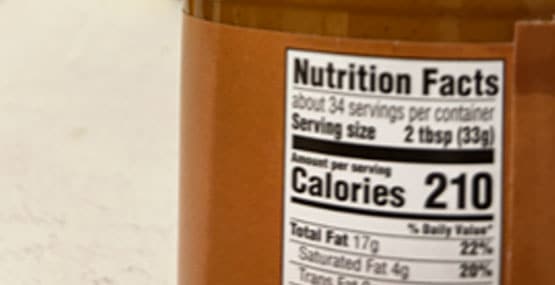
Decoding food labels: What's in your food?
Understanding and using food labels can help you make heathier choices for you and your family
Food labels are like secret codes that tell us what's inside the packaged food we buy. Have you ever looked at a food label and wondered what all those numbers and words mean? Once you fully understand how to decode food labels, you can make healthier choices when you shop for groceries.

What is a Food Label?
A food label is the sticker or tag on a package of food that gives you important information about what's inside. It basically tells you what you're about to eat. Food labels are required by law, and they can help you make smart decisions about what to eat. And they are much more reliable than the advertisements on the front of the package.
The important parts of a food label:
- Nutrition Facts: This is the most important part of the label. It tells you how many calories are in a serving, and it also shows you how much fat, sugar, protein, and other nutrients are in the food.
- Serving Size: This tells you how much of the food is considered one serving. Be careful! Sometimes a package has more than one serving, so you may need to do some math to figure out how many calories and nutrients you're actually getting. Believe it or not, there's a cookie company that claims a serving size is ¼ of their regular cookie, with only 180 calories! But who eats ¼ cookie? Eat the whole thing, and you've put over 700 calories on your waistline—and you'd probably have to run 7 miles to take them off.
- Ingredients List: This is a list of all the things that are in the food. Ingredients are listed in order from the largest amount to the smallest amount. So, if sugar is the first ingredient, that means there's a lot of sugar in the food.
- Allergen Information: If a food contains common allergens like nuts, milk, or wheat, it will be listed here. This is important for people who have food allergies.
Understanding the Nutrition Facts
The Nutrition Facts section is a map for your meal. Here's what you'll find there:
- Serving Size: This shows you how much of the food makes up one serving. It could be a cup, a slice, or even just a few chips. Pay attention to this, because the rest of the information is based on this serving size. But know that the percentages listed for the ingredients are based on a 2000 calorie intake. Some of us eat less; some eat much more.
- Calories: This tells you how much energy you'll get from one serving of the food. If you're trying to keep track of your calorie intake, this number is important.
- Fat: Fat is not always bad, but it's important to know how much is in your food. Look for labels that say "low fat" if you're trying to eat less fat.
- Saturated and Trans Fat: Trans and saturated fat are types of fat that are not very healthy for your heart. It's a good idea to limit your intake of foods high in these fats.
- Cholesterol: Cholesterol can build up in your blood vessels and affect your heart health. Try to choose foods with low cholesterol levels.
- Sodium: Sodium is another name for salt. Too much salt can be bad for your blood pressure, so watch out for high sodium levels. Its often high in soups, deli meats and packaged foods.
- Total Carbohydrates: This includes all the sugar and fiber in the food. Fiber is good for your digestion, so look for foods with higher fiber content.
- Sugars: This tells you how much sugar is in the food. Try to limit foods with a lot of added sugars.
- Protein: Protein is important for building and repairing your body's tissues. Make sure you're getting enough protein in your diet.
- Vitamins and Minerals: Some labels also show you the percentage of vitamins and minerals in the food. Look for foods that have higher percentages of important vitamins like vitamin A, vitamin C, and calcium.
Deciphering the Ingredients List
The ingredients list is like a recipe for the food. It tells you what's in there and in what order. Here's how to make sense of it:
- First Ingredient: The first ingredient on the list is the one that there's the most of in the food. So, if you're looking at a cereal box, and the first ingredient is "whole wheat," that's a good sign, since its high in fiber.
- Hidden Names: Sometimes, ingredients go by different names. For example, sugar can also be called "sucrose." "High fructose corn syrup," and "glucose" are similar sugars. So, even if you don't see "sugar" on the label, the food might still have a lot of sugar in it.
- Additives and Preservatives: Some foods have additives and preservatives to make them last longer on the shelf. These can be hard to pronounce, so it's a good idea to learn about them and decide if you want to eat them.
- Allergens: If you have food allergies, always check the ingredients list for allergens. They should be listed in bold or with a warning statement.
Conclusion
Food labels are like your secret weapon for making healthy choices at the grocery store. By understanding the Nutrition Facts, the Ingredients List, and paying attention to serving sizes, you can take control of your diet and make sure you're eating foods that are good for your body.
Next time you pick up a snack or a meal, take a moment to read the food label. It might help you make a healthier choice and help you live better in the long run. So, go ahead, decode those food labels, and eat smarter!
Sources
Harvard Health
https://www.health.harvard.edu/staying-healthy/the-truth-about-fats-bad-and-good
Mayo Clinic
https://www.mayoclinic.org/healthy-lifestyle/nutrition-and-healthy-eating/in-depth/fat/art-20045550
World Health Organization
https://www.who.int/news-room/fact-sheets/detail/food-additives
Nutrition4Kids




